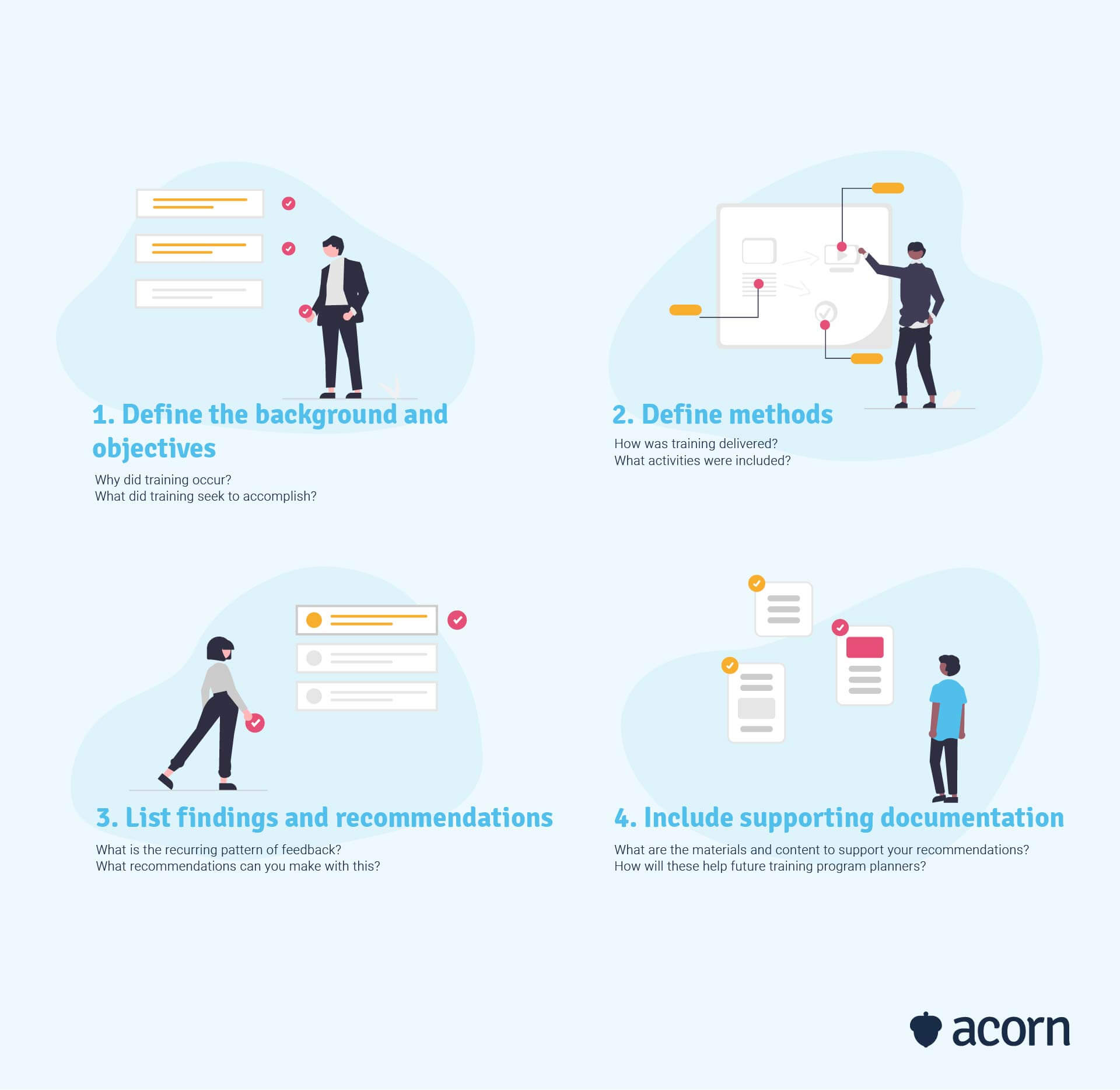The How, What, Why and Challenges of Collecting Training Feedback
Reading Time:

Lead the pack with the latest in strategic L&D every month— straight to your inbox.
SubscribeTraining feedback is the key to building effective training programs to maximise business impact.
Implementing the perfect training program in your organisation isn’t a simple task. As your business needs are constantly changing, so too are your training needs, and you need to be on top of the development and improvement of your training programs to do that.
This is where training feedback comes in. We’ll break down when and how to gather and implement training feedback in your build on your organisational capabilities. We’ve also included two free training feedback and training evaluation templates for you to download below.
What is training feedback?
Training feedback is the process of gathering information on training programs from your program participants with the purpose of identifying areas for improvement. It’s not exactly the same as training evaluation, which looks more into training effectiveness and business impact.
Why is feedback important in employee training?
Feedback is important to ensuring you’re providing training relevant to your business and employees. In short, it’ll be used to create actionable recommendations for your future L&D activities.
There are two important reasons to solicit feedback from learners:
- To analyse the efficacy of training
- To identify areas for improvement.
Here at Acorn, we’ve created the first performance learning management system (PLMS) to help you in gathering and analysing feedback and analytics on your training. A PLMS delivers a world where organisations attain peak performance by empowering their people with the information to reach their full potential as impact players.
Analysing the efficacy of training
There’s no point putting your employees through a training program if the program isn’t actually engaging them (and therefore, not helping them build capabilities). Any training program that lacks learner engagement is essentially a waste of time, money and energy you spent developing it.
This points to a few larger issues with your training program.
- Training doesn’t reflect the day-to-day reality of your employees and their responsibilities.
- Training outcomes or capability mapping isn’t aligned with employees’ job roles or learning pathways.
- Training isn’t aligned with desired business outcomes, sending confusing messages about your organisational goals.
Feedback gathered from participants on a training course is what allows you to perform an evaluation of training effectiveness, analysing participant satisfaction on the quality of the course in terms of how engaging it is, how much knowledge is retained, and how that retained knowledge has impacted business. (Think of your training ROI here.)
Identifying areas for improvement
Sometimes, training falls flat or just needs to be updated to fit with the changing business environment. You can use valuable feedback from survey participants here to identify which aspects of your training course is lacking. This could be in employee engagement, course content, knowledge retention, or relevance to participants and business strategy.
Training feedback is also what allows you to have a greater understanding of your training activities and the improvements that need to be made both while the training takes place and for future learning courses. Adjusting your learning programs based on feedback makes your training more effective, increasing knowledge retention and behavioural change, driving organisational transformation and developing your talents’ capabilities.
4 steps to writing a training completion report
A training report summarises and evaluates the positive and negatives of your training programs after they’ve been completed. There are four steps to writing a clear training report:
- Define the background and objectives
- Define methods
- List findings and recommendations
- Include supporting documentation.

1. Define the context and objectives
Start by defining the background context to your training. Outline a training summary and how you gathered data on your training sessions. Data might come from post-training survey questions, a trainer or course instructor, or reviews from participants.
Then you need to define the objectives of the training. These will be the expectations the business sets for learning and development. The two most important objectives you need to answer are:
- Why did training occur? (Think: addressing a capability gap or meeting a specific performance goal)
- What did business unit leaders seek to accomplish with the training program? (Think: closing specific capability and skills gaps.)
If you can’t define exactly why your training happened, then you won’t be able to measure learning effectiveness regardless of whether objections and expectations were met. And that only negates the justification for training in the first place, since you can’t show the business need for L&D.
2. Define the method
Next, you need to outline how the training was delivered and how long each form of training took. Consider content and activities like:
- Presentations
- Field trips or offsite learning
- Learning aids
- Workshops
- Guest speakers.
Be as detailed as possible here. Break down each individual exercise involved in the workshop or each activity covered in the field trip.
3. List findings and recommendations
Here, your feedback and survey data start to come into play. Use employee surveys and assessments to identify recurring issues or strengths flagged on the training course. Perhaps the responses reveal technical issues with how the training course was run, or key learning moments that could be expanded on.
You should be specific here, but don’t get too carried away listing each piece of feedback received in detail (the key words here are recurring, issues and strengths). Highlight responses that reveal a pattern of feedback from learners.
Once you have your key findings, you can move on to the most important step for your organisation’s future: Recommendations. These are informed suggestions on how to address issues that may have been brought to light in your training surveys.
This section is the most helpful for your organisation because:
- Your recommendations will be used to create and prioritise a development plan for future learning activities, better aligning your training programs with strategy and driving business impact.
- The data you collect helps to identify those priority areas by highlighting which aspects of your training programs need improving.
- Calculating the ROI in training as a result of improved learning activities will assist in winning stakeholder buy-in, allowing for better L&D resourcing.
When developing your recommendations, you should think about how following through on specific recommendations will give you the business outcome you desire, so that you can select the best path to meeting organisational strategy.
Remember, good training is repeated regularly to continuously improve your workforce, which means you’ll eventually end up with a lot of different training reports. You’ll want to record the basics of the training like the name, date and location to easily reference in the future.
4. Include supporting documentation
This includes documentation (like training materials and content) to support the suggestions put forward in your report, and will be helpful tools for training program planners.
Your training feedback template
If you’re in need of a feedback template, look no further! We’ve created a free training feedback template for you to adapt as you please.
The challenges of collecting training feedback
Collecting training feedback isn’t as simple as asking how participants feel about the program’s effectiveness or course materials after the training is completed. In fact, there are four common challenges when gathering feedback that hinder the quality and collection of evaluation data.
- A lack of willingness to gather feedback
- Taking the wrong approach
- A lack of planning
- Taking feedback after training.
A lack of willingness to gather feedback
Training without any form of feedback is ineffective and prevents your learning activities from being engaging or improving in the future. But getting feedback to analyse can’t happen without a willingness to set up evaluation methods (on your end) or participate in giving feedback (from your employees). A lack of willingness to give or gather feedback can be indicative of a few things.
- A lack of understanding of how training positively impacts employees and their roles.
- A lack of context behind the importance of training to business strategy.
- Resistance to future change.
This leads to training programs that don’t develop organisational capabilities and instead become a time and money sink preventing you from meeting business priorities.
You need to make sure you get buy-in from all the necessary stakeholders to ensure you get timely feedback on your course content and training quality. Make sure your participants understand the necessity of both training and honest feedback for the company and themselves and their professional development. And, importantly, make sure you show them a better way forward for themselves and the business.
Taking the wrong approach
Imagine this: You ask your learners to provide feedback on their training program, but their responses do nothing to identify areas needing improvement. You might be asking the wrong survey questions or using the wrong approach to gathering data in the first place.
To ensure you receive feedback that is both relevant and constructive, you should focus on specific details. Before your course delivery, sit down with the relevant stakeholders (managers, course designers, instructors, etc.) and discuss the best approach to take when you collect feedback. (NB: By “best approach” we mean determining your angle and your method—such as what questions you’ll be asking and whether you’ll collect feedback from anonymous surveys or face-to-face discussions.) Ask yourself what you’re measuring, when, and why.
A lack of planning
If you don’t decide on the most relevant and effective approach before you launch your learning content, you might find your feedback to be disorganised later on. Similarly, poorly planned evaluation activities will only deliver decentralised, irrelevant, or untimely feedback in return.
That could mean future training programs are misinformed by the wrong data, which means you won’t have an accurate picture of what areas of training need improvement, leading to ineffective and irrelevant training programs down the line.
Taking feedback after training
Collecting feedback after a training session isn’t inherently bad, but it raises issues when it’s just tacked on at the end like an afterthought. We’ve talked before about retention of knowledge and how employees lose information over time if they don’t review regularly, which means the longer your employees go between participating in a training program and giving feedback on it, the less accurate said feedback will be. And the less accurate your post-training surveys are, the less effective they are at solving issues in the moment of need or improving future training programs.
This isn’t to say you shouldn’t have any post-training evaluations. Post-training evaluations provide a crucial understanding of how training content has helped (or not helped, if that’s the case) your employees in their learning and development. But to combat the data challenges that arise from gathering feedback too late in the game, you need to collect real-time feedback (in the form of discussions or surveys from participants) during your training program to ensure you’re gathering accurate and valuable data.
Key takeaways
Training feedback shouldn’t be confused with training evaluation. It is its own important entity that’s closely tied to learner engagement and training effectiveness. Feedback on training plays a crucial role in improving L&D activities for the future in order to enact organisational change and drive business strategy.
To create continuous improvement of your training programs, remember to:
- Solicit feedback from learners throughout the training process, not just after
- Continuously gather feedback from learners throughout all training and development activities
- Define clear, actionable recommendations for training improvements.